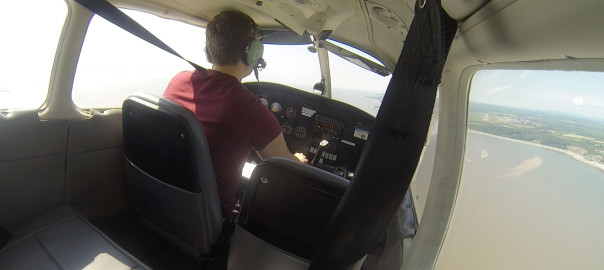This week I’d be flying solo to Cardiff, landing, and coming back. Cardiff has full ATC and is within a Class D CTR , unlike Shobdon, making it a more complex approach. The sun was out, the sky clear and I arrived at the airfield nice and early to prepare.
NOTAMs checked, Royal Flights checked, MET checked, weight & balance checked, fuel planning done, A-Check checked – everything checked! After a briefing from my instructor and some more paperwork (signing my life away, that sort of thing) I was in the aircraft on the apron, ready to taxi.
After a short taxi and hold, I was cleared for take-off and soon climbing out of Gloucester’s runway 22. Quite an ideal runway considering my destination, I barely had to change track to get to the magnetic heading I’d planned on my PLOG. As is usual departing Gloucester, shortly after departure Tower hands you to Approach, who provide a basic service and give you a reporting point. Usually when heading this way they ask you to report “at the bends” which means at the bends in the river – about 10nm from the airfield. Today was no exception.
After a top-of-climb FREDA check I did a quick gross-error check by comparing my expected position on the chart with what I could see, and everything was looking good. To be fair, it’s fairly hard to get lost on this route as you basically hug the shoreline the entire way.
After a few minutes I was at the bends and reporting to Gloucester Approach, who then suggest I freecall Cardiff. Before leaving, I obtained the Regional Pressure Setting (Cotswold) so that I can adjust my altimiter. When a radio change is prefixed with Freecall, it means that the current station have not passed your details to the next station, therefore you are calling them of your own free will. This is therefore not an instruction. Clearly, in this instance it makes perfect sense for me to talk to them, so I say goodbye to Gloucester and obtain Cardiff’s ATIS.
After noting down the ATIS information, I call Cardiff Approach. Their ATIS announcement says to report your aircraft type on first contact, and I forgot, but they didn’t seem to mind this time. Maybe they were going easy with me as I was a student?
After their “pass your details” request I launch in to the full CARPACER call. Shortly after they give me a Squawk for the transponder. I had noticed in the aircraft’s techlog that the previous pilot had noted ‘possible faulty transponder’ so I was unsure whether it would actually work or not (there was some debate in the office as to whether or not said person had actually had the thing switched on). After a minute or so, Cardiff ask me to check the Squawk so I tell them I think it’s faulty. No problem, I’m given a basic service and tell them my position so they can identify me manually on their radar.
Here’s a clip of me reporting to Gloucester, obtaining Cardiff’s ATIS and the subsequent calls with Cardiff Approach:
After a few minutes, as I get closer to the expected “VFR Cardiff Docks” arrival entry route, Cardiff Approach call me to give me my clearance to enter their control zone. Here’s a clip:
Runway 30 was in use, the opposite to what I had used when I flew here with my instructor. Landing at runway 30 involves flying along the coast and then turning right to approach the runway from over the sea (it’s right on the cliff edge). I’d been told by Tower to join right base, so as I start to position to join the circuit I do my pre-lander checks BUMFFFICHL.
As I turn on to final, I hear a Thomson commercial airliner flight given take-off clearance and I’m asked to orbit. Well, that’s a new one for me. Being told to orbit when you’re at 700ft on final approach (‘low and slow’). Nothing like something new to keep you on your toes! So I increased power, climbed a little and made a right orbit over Barry Island. After ending my orbit and reporting final, I didn’t have much time to get the approach speed and attitude right, but luckily as Cardiff’s runway is so massively long I didn’t need to worry too much about landing on the numbers.
At about 1nm on final, I’m given traffic information that a Cessna is passing behind me, routing around the coast. Bit distracting as it got me looking for the traffic, but I suppose I need to get better at multi-tasking. The landing was fairly uneventful, and I was soon parked on the south apron outside Aeros, and – more importantly – the airport pub/cafe.
The cafe was busy and had a 1.5 hour wait for food, so I had a quick diet coke and headed back out for the return leg. After doing the usual checks, I was on the radio to Cardiff Tower asking for permission to taxi. The return flight back to Gloucester was very straightforward, with an exit via the VFR Wenvoe route (to the East of the mast, near Cardiff Docks), followed by handover to Gloucester Approach who cleared me for an overhead join.
The landing was smooth and I headed back to Aeros for a debrief (and coffee!) with my instructor.

